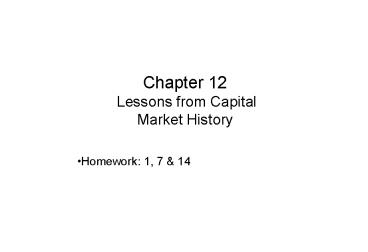T12.1 Chapter Outline - PowerPoint PPT Presentation
Title:
T12.1 Chapter Outline
Description:
into something easily convertible into money. Financial markets . . . not only make a hard asset liquid, they price that asset so as to promote it ... – PowerPoint PPT presentation
Number of Views:18
Avg rating:3.0/5.0
Title: T12.1 Chapter Outline
1
Chapter 12 Lessons from Capital Market History
- Homework 1, 7 14
2
Lecture Organization
- Percentage Return
- Historical Return and Risk Premium
- Measure of Risk
- The Efficient Market Hypothesis
3
Risk, Return, and Financial Markets
- . . . Wall Street shapes Main Street.
Financial markets transform factories, department
stores, banking assets, film companies,
machinery, soft-drink bottlers, and power lines
from parts of the production process . . . into
something easily convertible into money.
Financial markets . . . not only make a hard
asset liquid, they price that asset so as to
promote it most productive use. - Peter Bernstein, in his book, Capital Ideas
4
Percentage Returns
Total
42.18
Inflows
Dividends
1.85
Endingmarket value
40.33
Time
t
t 1
Outflows
37
5
Percentage Returns
Rates of Return
Percentage Return
Percentage Return
6
A 1 Investment in Different Types of Portfolios
1948-1999
7
A 1 Investment in Different Types of
Portfolios 1926-1998 (US Comparison)
8
Year-to-Year Total Returns on TSE300 1948-1999
9
Year-to-Year Total Returns on Small Company
Common Stocks 1970-1999
10
Year-to-Year Total Returns on Bonds 1926-1998
11
Year-to-Year Total Returns on Treasury Bills
1948-1999
12
Using Capital Market History
- Now lets use our knowledge of capital market
history to make some financial decisions.
Consider these questions - Suppose the current T-bill rate is 5. An
investment has average risk relative to a
typical share of stock. It offers a 10 return.
Is this a good investment? - Suppose an investment is similar in risk to
buying small Canadian company equities. If the
T-bill rate is 5, what return would you demand?
13
Using Capital Market History (continued)
- Risk premiums The risk premium is the
difference between a risky investments return
and that of a riskless asset. Based on historical
data - Investment Average Standard Risk return deviat
ion premium - Common stocks 13.2 16.6 ____
- Small stocks 14.8 23.7 ____
- LT Bonds 7.6 10.6 ____
- U.S. Common 15.6 16.9 ____ (SP 500 in C)
- Treasury bills 3.8 3.2 ____
14
TSE 300 Frequency of returns (1948-1999) Figure
12.5
15
Historical Returns and Standard Deviations
- Investment Average Standard Frequency return d
eviation - Small stocks 14.8 23.7
- Common stocks 13.2 16.6
- LT Bonds 7.6 10.6
- Treasury bills 3.8 3.2
16
The Normal Distribution
Probability
68
95
Return onlarge companystocks
gt 99
3 62.47
3 -36.22
2 -19.77
1 -3.32
013.13
1 29.58
2 46.03
17
Asset mean returns versus variability 1948-1999
Standard Mean Deviation Inflation
4.25 3.51 T-bills 6.04 4.04 Bonds
7.64 10.57 TSE300 13.20 16.62 Small
Stocks 14.79 23.68
18
Asset mean returns versus variability 1948-1999
19
Expected Returns and Risk
- Returns are important, but they cant be the sole
driver of investment decisions - Risk-free Rate
- The rate of return that can be earned with
certainty - Risk Premium
- Difference between return and risk-free asset
return - Volatility
- The standard deviation of asset returns
- Risk Aversion
- The degree to which an investor is willing to
accept risk
20
Do We Like Risk?
- Coin-Flipping game
- Wonderland and Kings Island
- Las Vegas
21
Example
- Using the following returns, calculate the
average returns, the variances, and the standard
deviations for stocks X and Y. -
Returns - Year X Y
- 1 18 26
- 2 6 -7
- 3 -9 -20
- 4 13 31
- 5 7 16
22
Solution to Example
- Mean return on X
- Mean return on Y
Variance of X Variance of Y
Standard deviation of X Standard deviation of
Y
23
Two Views on Market Efficiency
- . . . in price movements . . . the sum of
every scrap of knowledge available to Wall Street
is reflected as far as the clearest vision in
Wall Street can see. - Charles Dow, founder of Dow-Jones, Inc. and
first editor of The Wall Street Journal (1903) - In an efficient market, prices fully reflect
available information. - Professor Eugene Fama, financial economist (1976)
24
Reaction of Stock Market to New Information
25
Efficient Market
- Efficient Market Hypothesis (EMH) states that
asset prices fully reflect all available
information - Active strategies do not work systematically due
to competitive market environment - EMH recommends a passive portfolio investment of
investment in a well-diversified portfolio
without attempting to find mispriced
securities.
26
Market Efficiency
- Information is the key. Market prices
incorporate information quickly. - What information is included in prices?
- Weak form
- Semi-strong form
- Strong form
All insider info
All public info
Past prices
27
Implications
- Suppose markets are weak form efficient
- Implies information from past trading history of
security, or technical analysis, cannot help
investors identify systematic mispricing. Why? - Suppose markets are semi-strong form efficient
- Suppose markets are strong form efficient
28
Implications
Semi-strong
Strong
Weak
29
Implications
- EMH implies stock prices are a Random Walk
- Stock price changes should be random and
unpredictable (Why? Is this bad?)
30
Empirical Evidence on Market Efficiency
The Empirical Evidence tells us three main
things































